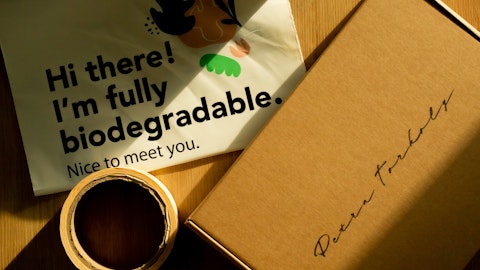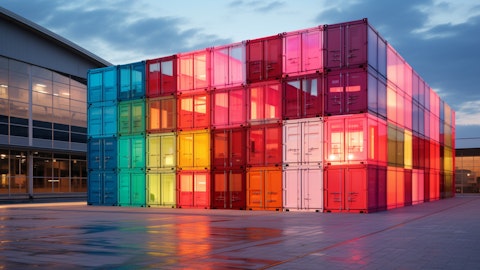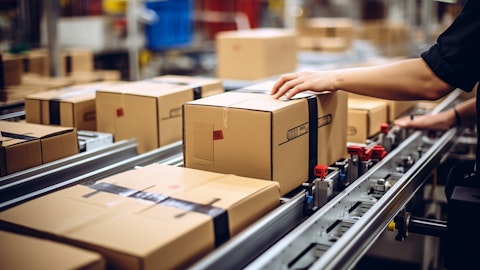Packaging Corporation of America (NYSE:PKG) Q1 2024 Earnings Call Transcript April 23, 2024
Packaging Corporation of America isn’t one of the 30 most popular stocks among hedge funds at the end of the third quarter (see the details here).
Operator: Good morning, everyone, and thank you for joining Packaging Corporation of America’s First Quarter 2024 Earnings Results Conference Call. Your host today will be Mark Kowlzan, Chairman, Chief Executive Officer of PCA. Upon conclusion of his narrative, there will be a question-and-answer session. And please also note today’s event is being recorded. At this time, I’d like to turn the floor over to Mr. Kowlzan. Please proceed when you are ready.
Mark Kowlzan: Thank you, Jamie. Good morning, everyone, and thank you for participating in Packaging Corporation of America’s first quarter 2024 earnings release conference call. Again, I’m Mark Kowlzan, Chairman and CEO of Packaging Corporation of America. And with me on the call today is Tom Hassfurther, Executive Vice President who runs the Packaging business, and Bob Mundy, our Chief Financial Officer. I’ll begin the call with an overview of our first quarter results, and then I’ll be turning it over to Tom and Bob, who will provide further details. And then I’ll wrap things up and we’d be glad to take questions. Yesterday, we reported first quarter net income of $147 million or $1.63 per share. Excluding special items, first quarter 2024 net income was $155 million or $1.72 per share compared to the first quarter of 2023’s net income of $198 million or $2.20 per share.
Our first quarter net sales were $2 billion in 2024 and 2023. Total company EBITDA for the first quarter, excluding special items, was $333 million in 2024 and $405 million in 2023. First quarter net income included special items expenses of $0.09 per share, primarily for certain costs at our Jackson, Alabama mill for the paper to containerboard conversion-related activities. Details of special items for both the first quarter of 2024 and 2023 were included in the schedules that accompanied our earnings press release. Excluding the special items, the $0.48 per share decrease in first quarter 2024 earnings compared to the first quarter of 2023 was driven primarily by lower prices and mix in the Packaging segment for $1.33, and Paper segment $0.08, higher scheduled mill outage expense $0.10, higher depreciation $0.03, higher expenses related to corrugated plant capital projects of $0.02 and other expenses $0.04.
These items were partially offset by higher volumes in the Packaging segment for $0.71, and Paper segment $0.06. We also had lower operating and converting costs of $0.15 driven by very good process efficiencies and control over other usages of fiber, chemicals, energy, materials and labor. Although energy prices were lower versus last year’s first quarter, they were more than offset by higher recycled fiber prices. In addition, we had lower freight and logistics expenses for $0.04, lower interest expense $0.07 and lower tax rate $0.09. The results were $0.18 above the first quarter guidance of $1.54 per share, primarily due to the strong volume in both the Packaging and Paper segments, along with the continued emphasis on cost management and process efficiencies across our manufacturing and converting facilities.
This drove operating and converting costs lower even with the persistent inflation we continue to experience across most of the cost structure. Executing the conversion outage at our Jackson, Alabama mill better than planned resulted in lower scheduled mill maintenance outages, expenses and freight and logistics expenses were less than guidance as well. Looking at the Packaging business, EBITDA, excluding special items in the first quarter of 2024 of $326 million with sales of $1.8 billion resulted in a margin of 18.1% versus last year’s EBITDA of $392 million or sales of $1.8 billion or 21.7% margin. Throughout the quarter, containerboard and corrugated products demand exceeded our expectations. In addition to outstanding operational performance at our box plants and containerboard mills, we were able to service the high demand from excellent execution of the convert — of the conversion outage at our Jackson mill.
This enabled us to restart both machines earlier than anticipated and we completed our work prior to the quarter-end rather than in the month of April, which had been the original plan. Despite these efforts, with the higher demand, we ended the quarter at a record-low weeks of inventory supply for this time of year. With just our Filer, Michigan mill having a scheduled maintenance outage in the second quarter, we do expect to build our inventories back to targeted levels by the end of this quarter. I’ll now turn it over to Tom, who will provide further details on containerboard sales and the corrugated business in general.
Tom Hassfurther: Thanks, Mark. As Mark mentioned, Packaging segment volume for the quarter exceeded our guidance estimates. Corrugated product shipments per workday were up 11% and total shipments with one less shipping day were up 9.2% compared to last year’s first quarter. Compared to the pre-COVID period of the first quarter of 2019, shipments were up over 10.4% on a per day basis. Outside sales volume of containerboard was 40,000 tons above last year’s first quarter and 15,000 tons below the fourth quarter of 2023. Our order backlog remained incredibly strong throughout the quarter, and although demand continues to be challenged by constant inflation, higher interest rates and other factors, we expect to continue this positive momentum as we enter the second quarter.
Domestic containerboard and corrugated products prices and mix together moved slightly higher from the fourth quarter of 2023 levels by $0.01 per share, which was less than we anticipated due to our total announced increase not being recognized in the published benchmark prices. Versus the first quarter of 2023, prices and mix were down $1.19 per share. Export containerboard prices and mix were down $0.01 per share compared to the fourth quarter of 2023 and down $0.14 per share compared to the first quarter of 2023. I’d like to point out that the capital spending and optimization strategy within our box plant system that we have been continuously focused on over the last few years is providing incredible benefits. This has allowed us to focus on the mix of customers we want to profitably grow our revenues with by providing them the product and service needs they desire and allows them to grow.

Based on our current demand outlook for this year, this strategy has us on pace to set a new record for box shipments per plant. I’ll now turn it back to Mark.
Mark Kowlzan: Thanks, Tom. Looking at the Paper segment, EBITDA excluding special items in the first quarter was $41 million with sales of $164 million or 25% margin compared to the first quarter of 2023’s EBITDA of $41 million and sales of $151 million or 27% margin. Sales volume, which exceeded our guidance estimates, was 14% above the fourth quarter of 2023 and 16% above the first quarter of 2023. Demand was very good both from our existing customers as well as incremental volume from some new customers as we acquire — that we acquired towards the end of 2023. Orders remain strong as we enter the second quarter, although volume will be impacted by the scheduled maintenance outage at our International Falls, Minnesota mill in June.
An improved sales mix moved paper prices slightly above the fourth quarter of 2023, although prices and mix were down about 6% from last year’s first quarter. This past February, we announced $100 price increase across all of our paper grades and we began implementing these increases on April 1. I’ll now turn it over to Bob.
Bob Mundy: Thanks, Mark. Cash provided by operations during the quarter totaled $260 million and free cash flow was a first quarter record $184 million. The primary payments of cash during the quarter included capital expenditures of $77 million and dividend payments of $112 million. Excluding the invested cash proceeds from the bond transaction we mentioned on last quarter’s call, our quarter-end cash balance, including marketable securities was approximately $900 million with liquidity of $1.2 billion. Due to the excellent execution of the conversion outage at the Jackson mill that Mark spoke of and moving the International Falls mill outage from the third quarter and into the second quarter, we are revising the scheduled mill outage guidance we provided on last quarter’s call.
The revised total company estimated cost impact for the year is now $0.89 per share versus $0.96 per share previously. The actual impact in the first quarter was $0.24 per share and the revised estimated impact by quarter for the remainder of the year is now $0.18 per share in the second quarter, $0.14 in the third, and $0.33 per share in the fourth quarter. I’ll now turn it back over to Mark.
Mark Kowlzan: Thanks, Bob. Looking ahead, as we move from the first and into the second quarter in our Packaging segment, we expect continued strong demand and higher corrugated products and containerboard shipments. Prices and mix will move higher due to our announced price increases and increase in published domestic index prices as well as higher export prices. Orders in our Paper segment are expected to remain strong, however volumes will be lower due to the scheduled maintenance outage at the International Falls Minnesota mill during the quarter. Although we’re implementing our recently announced paper price increases, the average prices and mix are expected to be slightly lower due to the published decrease in index prices earlier this year and how that impacts contract triggers with certain customers.
Operating and converting costs should be slightly lower, primarily due to the sequential improvement in seasonal weather and wage and benefit timing expenses that we incurred in the first quarter and scheduled maintenance outage expenses will be lower. Rail rate increases at six of our mills during the first and second quarters will result in higher freight and logistics expenses and depreciation expense will be higher. Finally, our tax rate will be sequentially higher due to the tax-related benefit of share-based compensation vests in the first quarter. Considering these items, we expect the second quarter earnings of $2.07 per share. With that, we’d be happy to entertain any questions, but I must remind you that some of the statements we’ve made on the call constitute the forward-looking statements.
The statements were based on current estimates, expectations, and projections of the company and do involve inherent risks and uncertainties, including the direction of the economy and those identified as risk factors in the Annual Report on Form 10-K on file with the SEC. Actual results could differ materially from those expressed in the forward-looking statements. And with that, Jamie, I’d like to open up the call for questions, please.
See also 12 Highest Yielding Dividend Stocks You Can Buy Right Now and 30 Largest Stock Exchanges in the World.
Q&A Session
Follow Packaging Corp Of America (NYSE:PKG)
Follow Packaging Corp Of America (NYSE:PKG)
Operator: [Operator Instructions] Our first question today comes from George Staphos from Bank of America Securities. Please go ahead with your question.
George Staphos: Hi, everyone. Good morning. Hope you’re doing well. Thanks for the details. I guess the first question, maybe the standard one for all of us, can you talk to what the early trends are in terms of bookings and billings so far in 2Q? And then I had a couple of follow-ons.
Tom Hassfurther: George, this is Tom. Yeah, bookings remain very strong, as I indicated in the — in the call earlier in the script, were up 8% as of now. And we can — we expect a strong second quarter and the remainder of the year as well.
George Staphos: Thanks for that, Tom. Can you talk a bit about what your vertical integration was in 1Q and also in 4Q? And if you don’t want to provide — and we understand an absolute level, can you talk about what the relative trend was? And similarly, can you talk about how the mix of your business was, third-party in export in 1Q and similarly relative to what you saw in 4Q?
Mark Kowlzan: Bob?
Bob Mundy: Yeah, yeah, I don’t have the absolute — yeah, the integration in the first quarter was around 90%, almost 93%, George. And slightly below that, I think it was in the fourth quarter.
Mark Kowlzan: Thanks, Bob.
George Staphos: Okay. I guess the last one, and I’ll — please go ahead.
Mark Kowlzan: Yeah, Tom, do you want to comment about mix and…
Tom Hassfurther: Right. Are you asking about mix of export or you ask — what exactly you’re asking, George?
George Staphos: Really, I was asking about how much was export tonnage 1Q either directionally versus 4Q in absolute terms in terms of percentage of tonnage, whatever sort of qualitative or quantitative data you could provide us 1Q and 4Q. And really the last question related to it and I’ll turn it over is, you know for all of the volume, kudos to you in terms of the shipments, the operating — the EBITDA margin was less than we had been modeling for. And I’m trying to figure out where that loss of margin, at least versus our model, maybe we’re just too optimistic was whether it was a mix or something else in terms of the quarter. Thank you. I’ll turn it over there.
Tom Hassfurther: Let me see if I can tie this together here real quick for you, George.
George Staphos: Thank you.
Tom Hassfurther: Number one is the export. The export in first quarter versus fourth quarter, as I indicated was down slightly. Fourth quarter is a big export time for us. And — but on an overall basis, it was pretty flat. Relative to the EBITDA margins, I think one of the things that probably you might be missing in the model was the fact that the $20 downturn that took place last year, some of that bled into the first of the year because of contract triggers. And of course, we were counting on the $70 being published and the only $40 was published and it was slightly delayed. So the roll through in the price increase did not occur quite as quickly as we had hoped and not in the same amount because of the index. In addition to that, I just want to remind you that inflation remains very sticky.
And I think there is a lot of noise around inflation, the rate of inflation having slowed from that rapid rate during COVID, but it’s still going up. And it’s been going up, at the same time, the index has indicated prices going in the opposite direction until this $40 increase. So I think that’s — I think that’s where the — where the margin gap is.
Mark Kowlzan: George, there’s a lot of elements within the cost structure that people lose sight of. I mean, if you keep in mind, I mean things just like general services that a paper mill or box plant relies on, all these associated costs to run the business are up dramatically over the last few years and they’re not easing up. Bob, do you want to comment on this? Again, I think people are truly, truly missing that.
Bob Mundy: Yeah. Yeah, Mark. I mean the things and even as we go into the second quarter from the first, obviously, recycled fiber, wood may be a little bit higher from a price standpoint, electrical rate, even though gas is down, electrical rates are not. Chemicals, whether it be lime, adhesives in the box plants, resins, alums, starch across the board, all moving higher. And again, we typically talk about all the direct type of costs and which is only about 40% of our cost base, you have the other 60% which are, as Mark referenced, there are maintenance services, repairs, materials, operating material supplies, property taxes, rent, warehouse cost, insurance leases. So it’s — there is constant inflation and all the people that supply those things, they have the same inflation going on in their business and they don’t eat it. They pass it on to us. So a lot of that just gets overlooked, I think, George.
George Staphos: I appreciate all the color, guys. I’ll turn it over. Thank you very much.
Mark Kowlzan: Thank you. Next question, please.
Operator: Our next question comes from Michael Roxland from Truist. Please go ahead with your question.
Nicco Piccini: Thank you, Mark, Tom and Bob for taking my questions. This is Nicco Piccini on for Mike. I guess just realizing that demand has improved across the board, are there any particular sectors or end-markets where you saw more notable improvement, and then anything lagging?
Mark Kowlzan: I can tell you, the demand improved across the board, believe it or not. When we look at the various segments, whether it’s e-com, ag, food, even in the heavier manufacturing area, we had significant improvement across the board.
Nicco Piccini: Got it. Thank you. And then just following up, since roughly 2019, you spent like a deal of time and money recapitalizing your box plants. Can you comment on maybe if there’s anything left to do there realizing there’s always some level of work to be done?




